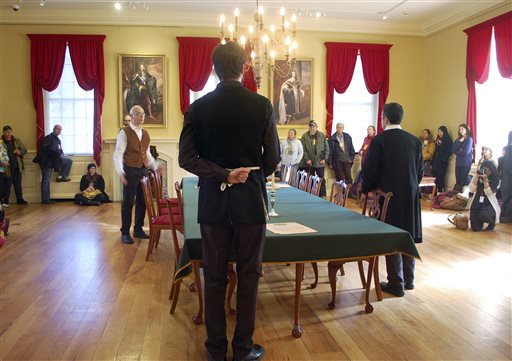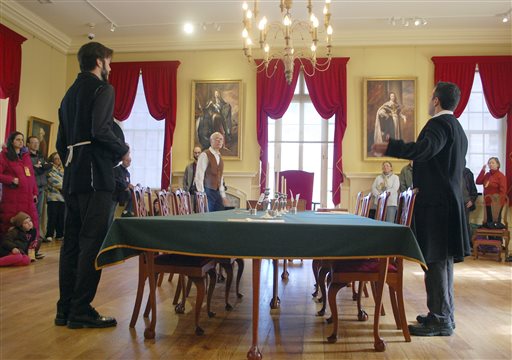
BOSTON — Stand in front of the Old State House today and you’ll see a mix of college students, business professionals and tourists whiz past Boston’s oldest public building. But nearly 250 years ago, it was ground zero for a bloody standoff that helped put a ragtag band of American colonists on the road to revolution.
Now that 1770 melee — famously known as the Boston Massacre, and a turning point in the violent break from British tyranny — has inspired a new stage play.
“Blood on the Snow” will be performed in May in the very same room where the colonists agonized over their options and how to heal their shattered town, bringing to life the history that played out in the raw aftermath of the slaughter.
The play, a production of the Bostonian Society in partnership with the National Park Service, tells the story of how Massachusetts Gov. Thomas Hutchinson managed to forestall more violence between British soldiers and colonists on the day following the attack.
But the slaughter touched off a political crisis that would set the colonists on the path to independence.
“It is a fascinating picture of someone who was really between a rock and a hard place,” said Dale Place, the actor who plays Hutchinson. “It comes to a resolution through compromise. He had to bend.”
In the run-up to the massacre, Boston — one of colonial America’s largest cities — had become unruly and overrun by mobs. The presence of British soldiers served only to inflame the colonists.

On March 5, 1770, things came to a head when angry colonists started throwing rocks and pieces of frozen manure at a small group of soldiers stationed outside the Old State House.
The soldiers became unnerved and fired their muskets into the crowd, killing five and wounding at least eight.
“After this you begin to see a divide between them and us,” said Nathaniel Sheidley, a historian with the Bostonian Society who consulted for “Blood on the Snow,” speaking from the standpoint of the British. “This crystallized the impact of living in an occupied town — that our soldiers killed innocents.”
Hutchinson, a loyalist to the king of England, had felt protected by the roughly 2,000 British troops who had rotated through Boston in the 18 months preceding the attack. He was worried about his political future, but faced extreme pressure to stop the disorganized and ill-prepared colonists from rising up on the day after the attack.
“Blood on the Snow” follows Hutchinson’s political maneuvering in the tense hours after the massacre, which ultimately steeled the colonists’ resolve to govern themselves.
“We get beyond what happened and look at why what happened matters,” said Patrick Gabridge, who wrote the play.
The setting for the play is the Council Chamber of the Old State House, the same room where Hutchinson deliberated with his advisers.
The play, which runs from May 12-29, will be an intimate experience: Audiences will be limited to 50 people, and they’ll be seated around a table in the middle of the room — essentially placing them at the elbows of the forefathers.
“At the heart of it all is an emotional outcome: the tremendous emotional blow that moment had on the town of Boston,” Sheidley said. TVJ












































